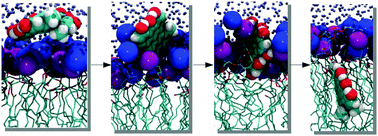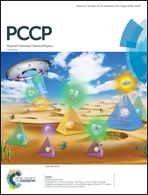Deciphering the photosensitization mechanisms of hypericin towards biological membranes†
Abstract
Resorting to state-of-the art molecular modeling and simulation techniques we provide full characterization of the photophysical properties of the naturally occurring hypericin chromophore, currently used in photodynamic therapy. In particular, we reveal the different photophysical pathways leading to intersystem-crossing and hence, triplet manifold population that is necessary for the subsequent production of singlet oxygen. In particular we identify an extended region of quasi-degeneracy between the first singlet excited state and three triplet state surfaces. This energetic factor allows the occurrence of intersystem-crossing even in the presence of a relatively small spin–orbit coupling. Furthermore, thanks to extended all-atom molecular dynamics simulations we provide insight into the interaction of hypericin with lipid bilayers. We demonstrate the formation of stable interactions with the membrane and, in particular, the penetration of hypericin into its hydrophobic core. This organization allows a spatial overlap between hypericin and the lipid oxidizable double bond pointing towards the production of singlet oxygen in close spatial proximity to its reactant, hence favoring photosensitization.



 Please wait while we load your content...
Please wait while we load your content...